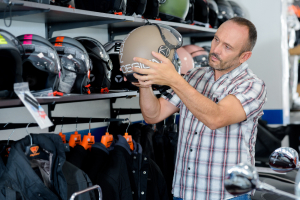







Home » Motorcycle Helmet Laws in Illinois


Are you well-versed in the complexities of motorcycle helmet laws in Illinois? Fret not, as Conboy Law is here to be your guiding light through the intricate world of these regulations. Our expertise in motorcycle helmet law and unwavering commitment to protecting riders’ rights make us the go-to firm for motorcyclists across the state.
In this concise yet comprehensive guide, we’ll explore the ins and outs of Illinois’ motorcycle helmet laws. Ensuring you have the knowledge to ride safely and follow the law. With Conboy Law, you can confidently embark on your two-wheeled adventures. Knowing you have the best legal support in the industry.
Table of Contents
ToggleLike other states, Illinois has laws governing how motorcyclists and other motorists operate their vehicles on public roadways. You should be aware of these laws and be prepared to follow them to stay safe. If you violate any of them, it may influence who is held accountable for your injuries in the event of an accident.
Illinois has no motorcycle helmet law, so motorcyclists are not compelled to wear helmets while riding a motorcycle. However, Illinois requires motorcyclists to wear eye protection, which can be as basic as shatterproof sunglasses, a windshield, or a windscreen. Illinois joins Iowa and New Hampshire as the only states without a helmet law.

Some states that do not have obligatory helmet legislation for adults have passed laws requiring youngsters to wear helmets. Motorcycle riders under the age of 18 or 21, depending on the state, may face more strict requirements than older riders. This balance protects younger riders.
Younger motorcycle riders are more prone to making hasty judgments while allowing everyone else to make their own decisions. Minors are not required to wear motorcycle helmets in Illinois as of 2020.
Motorcycle riding can be an exhilarating experience, but prioritizing safety is essential. In Illinois, understanding motorcycle helmet requirements is crucial for every rider. The National Highway Traffic Safety Administration (NHTSA) has published a comprehensive guide to motorcycle helmets that can serve as a valuable reference. Below, we will discuss the essential aspects of choosing the right motorcycle helmet, as outlined by the NHTSA.
Ensure a Proper Fit

Selecting a helmet tailored to your head’s shape is vital for safety and comfort. There are three distinct head shapes: round oval, long oval, and intermediate oval. Each shape requires a different helmet to ensure a secure fit.
Measure Your Head
To find the perfect helmet size:
A loose helmet will not provide adequate protection, whereas a tightly fitted one will offer optimal safety.
Choose the Right Style

Your riding habits should dictate the style of helmet you select. For example, off-road riders may need a different helmet type than those primarily using highways. It’s essential to choose a helmet designed for your specific riding conditions.
Look for the Department of Transportation (DOT) Symbol
Helmets meeting Federal Motor Vehicle Safety Standard No. 218 will display the DOT symbol. Indicating they have passed minimum safety requirements set by the federal government. Always opt for a helmet with this mark to ensure you receive the finest protection possible.
Avoid Inappropriate Helmet Options
Bicycle helmets and costume helmets are not suitable for motorcycle use. They do not meet the necessary motorcycle rider safety standards. Also, they will not provide sufficient protection in the event of an accident. Stick to motorcycle helmets with the appropriate markings and specifications for your safety.
The Federal Motor Vehicle Safety Standard 218, legislated by the United States Department of Transportation, establishes guidelines for designing and manufacturing motorcycle helmets. The 218 standards require helmets to protect at particular speeds and impact levels.
In addition to the FMSVSS 218 requirements, the Snell Memorial Foundation maintains its motorcycle safety standards. While the Snell requirements are optional, many motorcycle riders adhere to them for more safety considerations. Snell certification indicates that a motorcycle helmet is of high quality.

No law in Illinois compels motorcycle riders to wear a helmet. But safety advocates tell motorcyclists to do so for their safety. Unfortunately, regardless of how careful or skilled a rider is, a reckless motorist can cause terrible. And potentially fatal injuries in motorcycle crashes.
Helmets are not required for motorcycle passengers or operators in Illinois.
Yet, the law compels drivers and riders to wear glasses, goggles, or a transparent shield to protect their eyes. “Glasses” denotes standard eyepieces worn in front of the eye. Like eyeglasses or sunglasses constructed of shatter-resistant material, according to Illinois law. The term “goggles” refers to a device that protects the eyes while allowing peripheral vision. The goggles must provide front and side protection and may or may not create a complete seal with the face.
A “transparent shield” is a windscreen affixed to the front of the bike. That reaches above the driver’s eyes when sitting in a typical, upright riding position. A “transparent shield” also comprises a face shield that covers the wearer’s eyes and faces up to about the tip of the nose. All clear guards must be shatter-resistant.
While there are no helmet laws in Illinois, this is not the situation in Indiana or Wisconsin. Helmets are required in both states. Neither state requires universal helmet use. Helmets are required for all drivers 17 and under in Indiana and Wisconsin. Wisconsin goes a step further, requiring anyone operating a motorcycle under a learner’s permit also to wear a helmet.
Furthermore, even if they are over 17, all passengers riding with a driver with an instruction permit must wear a helmet. Helmets are not required for all other cyclists. In terms of fatality rates, both states are comparable to Illinois. A biker was involved in 12.3% of all motor vehicle fatalities in Indiana in 2016. In Wisconsin, the figure was slightly higher, at 14%.

Sporting a helmet while riding a motorcycle is not only a matter of conforming with the law in some states. It also provides many benefits that improve your safety and riding experience. Here are three key advantages of wearing a helmet while on a motorcycle:
One of the primary purposes of a helmet is to shield your head from potential injuries during a motorcycle accident. Helmets are intended to absorb the impact of a collision. Reducing the risk of traumatic brain injuries and skull fractures. This vital protection can often make the difference between life and death.
A motorcycle helmet with a visor or face shield can improve your riding visibility. You can maintain better situational awareness by protecting your eyes from wind, debris, and harsh sunlight. And prevent accidents before they happen.
Motorcycle helmets are a barrier against various elements, such as rain, hail, extreme temperatures, and debris that could be scattered from the road. This protection adds to your comfort and reduces distractions that could compromise your safety.
Illinois, Iowa, and New Hampshire are among the states that currently do not have a universal motorcycle helmet law. Riders in these jurisdictions who oppose these rules are liberty-minded and claim it should be a choice for them whether to wear a helmet or not.
Below we will explore these arguments in detail.
Opponents of motorcycle helmet laws argue that individuals should be free to choose whether to wear a helmet or not. They believe the government should refrain from intervening in personal choices, especially about activities impacting the individual. This perspective values the freedom to make decisions about one’s safety and well-being above potential reductions in accidents and fatalities.
Some motorcyclists find helmets uncomfortable or inconvenient to wear. They may feel that helmets reduce their field of vision, impair hearing, or cause discomfort during long rides. These riders argue that the drawbacks of wearing a helmet outweigh the potential safety benefits. And they should have the option to forego wearing one if they choose.
Helmets can be expensive, with high-quality options often costing several hundred dollars. Critics argue that mandatory helmet laws place an undue financial burden on riders. Particularly those who cannot afford to invest in a proper helmet. They believe citizens should be able to decide whether to divide their resources towards purchasing a helmet or using that money for other necessities.

Dealing with the repercussions of a motorcycle crash in Illinois can be challenging. But it’s crucial to remember that even if you weren’t wearing a helmet, you can still claim compensation. The absence of an Illinois motorcycle helmet regulation may be to your advantage. Guaranteeing your right to compensation.
The knowledgeable and experienced attorneys at Conboy Law are here to analyze your case. And help you comprehend the legal remedies available. Don’t face the complexities of your accident case alone. Reach out and speak with our Illinois motorcycle accident lawyers today at (312)726-9000. This important step protects your rights and paves the way toward a fair and just resolution.
Search
If you or a loved one has been injured, don’t hesitate to contact our injury attorneys today!
"*" indicates required fields



60 W Randolph St. 4th
Floor Chicago, IL 60601
Monday to Friday:
Saturday:
Sunday:
Available For Calls
8:00 AM – 8:00 PM
9:00 AM – 5:00 PM
Closed
24/7
Chicago and surrounding areas